-
收藏模板
- 模板信息
- 更新时间:2023-09-22
- 字数:约17342字
- 页数:约10页
- 格式:.doc
- 推荐版本:Office2016及以上版本
- 售价:5 金币
您可能喜欢的文档
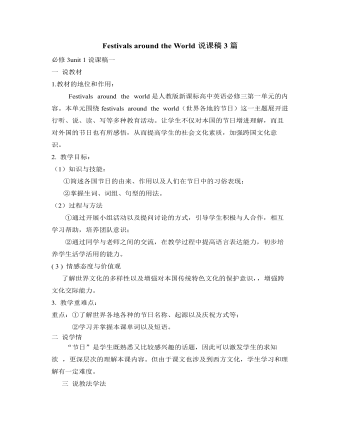
人教版高中英语必修3Festivals around the World说课稿3篇
Teaching plan for Unit 1 book3Good morning, teachers. It’s my great pleasure to be here because I can share my lesson with you and I can learn a lot from it. I’ll begin my lesson from the following four parts, the teaching material, the teaching methods, the studying methods and the teaching procedure.Firstly, let me talk about the teaching material. The content of my lesson is the reading passage festivals and celebrations of Unit 1 Festivals around the world. This passage is about festivals and celebrations. By studying this passage, we’ll enable the students to know that festivals exit everywhere, and many of festivals in different countries celebrate similar ideas. As we all know, the reading passage is the center of each unit. If the Ss can learn it well, it will be helpful to make the Ss learn the rest of this unit.After studying the teaching material, I think the teaching aims are as the followings:1. Knowledge aims:(1) The Ss can master the usage of the important words andexpressions.(2)The Ss can use the __________________ (grammar) in the proper situation.Make students know about the festivals all over the world and the detail of the festivals, such as origin, content, and the date of the holiday festivals.2. Ability aims:(1) Students can talk about festivals and celebrations in English(2) To improve the student’s reading ability, especially their skimming and scanning ability.3. Emotion aims:Make the Ss know about the foreign festivals, and respect other countries’ custom.Next, let’s come to the important points and the difficult points.The important point is how to make the Ss understand the text better and the difficult point is how can they talk about it. secondly, Teaching Methods:1. task-based Language Teaching2. Computer assisted language teaching.3. question-and–answer methodThirdly, Studying Methods:
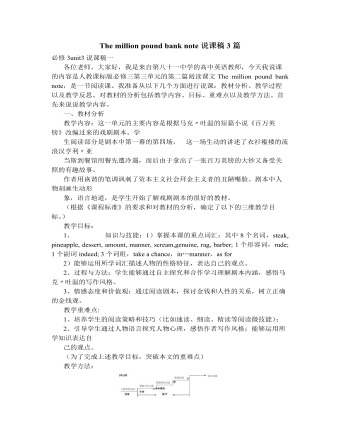
人教版高中英语必修3The million pound bank note说课稿3篇
在接下来的细读环节,我套用了高考对阅读理解的考查方式设置了5个问题,分别为三个推理判断题,一个细节题和一个主旨大意题。学生需要对文章的内容进行分析、归纳、推理、猜测等高级思维活动才能做出正确的回答。【设计意图】这一过程是对学生进行细读的训练,培养学生获取特定信息和挖掘文章深层次信息的能力。第三环节:Intensive-reading (精读) 15′第三个环节精读,既是最重要的环节,也是突破本课重难点的关键。首先,让学生思考剧本中人物看到百万英镑前后的态度发生了怎样的变化。其次,让学生仔细阅读文章,找出可以表现人物态度变化的具体的语言和动作。最后,让学生总结人物的态度发生变化的根本原因是什么,从而引出Money Talks, 供学生思考。【设计意图】通过一系列的活动培养学生学习从人物的语言和动作探究人物的心理,使学生进一步体会戏剧语言的魅力,从而对文章背后所反映的社会问题进行思考,也为下一步的讨论环节做好铺垫。
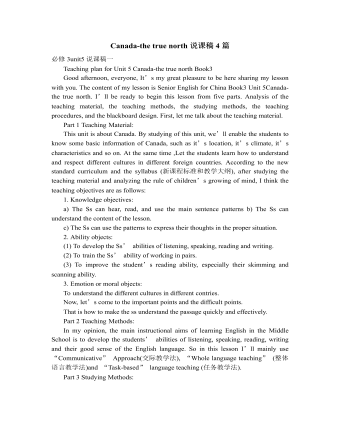
人教版高中英语必修3Canada-the true north说课稿4篇
Good afternoon, teachers, It’s my great pleasure to be here sharing my lesson with you.The content of my lesson is Senior English Book 3 Unit 5 Canada —— “The true North”.I’ll be ready to begin this lesson from five parts. Analysis of the teaching material,the teaching methods,the studying methods, the teaching procedure,and Blackboard design.First, let me talk about the teaching material.Part 1 Teaching Material:This unit is about the introduction of Canada. By studying of this unit,we’ll enable the students to learn the geography, population, main cities, and natural beauty, natural resources of Canada. Through the training of the unit, it also requires students to learn some Language skills such as the expressions of position and emotions.So it plays an important part in the English teaching in this book.After studying the teaching material and analyzing the rule of children’s growing of mind,I think the teaching aims are the followings:1.Knowledge objects:(1) make the students learn some new words and phrases(2) make the students understand the content of the lesson.2.Ability objects:(1)To develop the Ss’ abilities of listening, speaking, reading and writing. Especially reading and speaking ability.(2) learn to talk about the characters of Canada in English(3)To train the Ss’ ability of working in pairs.3.Emotion objects:(1)Enable students to understand the characters of Canada..(2)Stimulate Ss to work hard to make China stronger.Part 2 Teaching Methods:I think helping students learn to master new words and phrases and improve the students’ reading and speaking ability is import and the difficult.According to the analysis of the teaching material and the import points and the difficult points,I will use the following teaching methods : question-guiding approach; fast-reading and careful reading; multi-media teaching methods; discussion
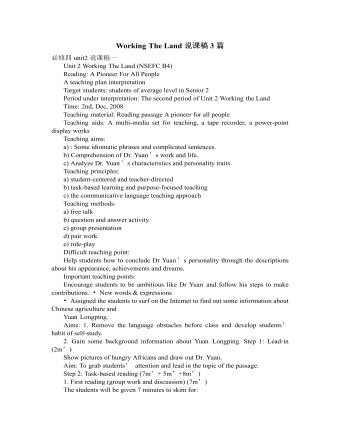
人教版高中英语必修4Working The Land说课稿3篇
Knowledge objectives:(1) to make Ss grasp the usage of words, expressions and sentence structures: statistics, struggle, thanks to, rid of, some patterns for persuasion, the “ing” form as subject and object;(2)to use learnt knowledge to persuade sb.Ability objectives:(1) to develop Ss’ reading skills(skimming, scanning, word guessing);(2) to improve Ss’ speaking, communicating and cooperating skills.Emotional objectives:to make Ss know the contribution of Yuan,and learn his spirit and his simple life time.Teaching important and difficult points:(1) some words, expressions and sentence structures mentioned above;(2)the content of the text;(3)training their reading and speaking skills.Teaching methods: CLT, TBLT,QT.Learning strategies: CLS, QLS, TBLS.Teaching procedures:Step 1 lead-in: (1) teacher plays a piece of recent news from CCTV about the harvest of the super hybrid rice, and ask students whether they know Yuan or not, and talk about him and his contribution.(2)Brain storm: let Ss describe Yuan in their minds including his appearance, his living condition and so on.Step 2 fast reading tasks:(1)teacher introduces Yuan and super hybrid rice(2)make Ss read the text as fast as possible with questions. Such as: what’s the general ideaof this passage? What’s Yuan’ dream? (skimming and scanning skill)Step 3 intensive reading tasks(1)let Ss read the text silently, find topic sentence of each paragraph and draw the difficult sentences and the knowledge what they don’t understand.(words guessing)(2)teacher and Ss talk about the important words, expressions and sentences together, and ask Ss to retell the content of the text.(summarizing and paraphrasing)(3)teacher summarize this part.(4) read again following the courseware.
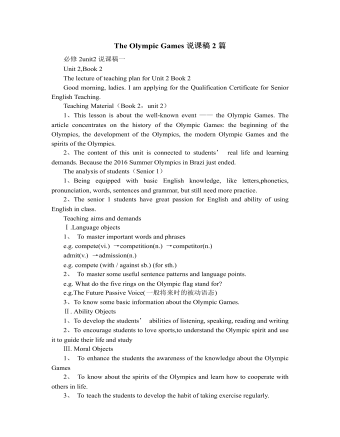
人教版高中英语必修2The Olympic Games说课稿2篇
Purpose of my design:To ask the students to do these two tasks will make the Ss predict the story of this passage. As a result, it will deepen Ss’ memory of this story because they will have their own understanding of this story.Step 3. While-readingTask 1. (Individual work _____min)Skimming: ask students to skim the text and the main ideas of each paragraph in this passage. Please read it quickly and then match the sentences with the letters.Task 2. (Individual work _____min)Scanning: read the text quickly and decide the whether the following statements are true or false and give reasons.Task 3. (Pair work _____min)Listen to the tape and fill in the banks. Then read the paragraph with expression to your partner.Task4 (individual work min)Listen to the tape again and write down the main idea in one sentence.Purpose of my design: Enable students to understand the given material better by using different reading skills. And proper competition can arouse the Ss’ interest in English learning. “Task-based” teaching method is used here todevelop the Ss’ ability of communication and also their ability of co-operation will be well trainedStep 4. Post-readingTask 1. (Individual work, pair work, group work, class work; _____min)Discussion (group of 4):1. If you were Hippomenes, would you run against Atlanta?2. Do you think Hippomenes deserved to win the race? Why or why not?Step 5. HomeworkPlease read the story again carefully after class and imagine: What will happen during the race between Hippomenes and Atlanta? Who do you think will win the race? Do you think Atlanta would marry Hippomenes? Write an end for the story with thses questions.Purpose of my design: Homework is so important and necessary for to master the knowledge they learned after class. It will check whether the Ss achieve the teaching aims.Part 5 Blackboard design
- 查看更多相关Word文档
Astronomy: the science of the stars说课稿3篇
必修3unit4说课稿一
Unit4 Astronomy: the science of the stars
Reading: How Life Began on the Earth
Interpretation
Good morning, ladies and gentlemen. It’s my great honor and pleasure to be here sharingmy lesson with you.
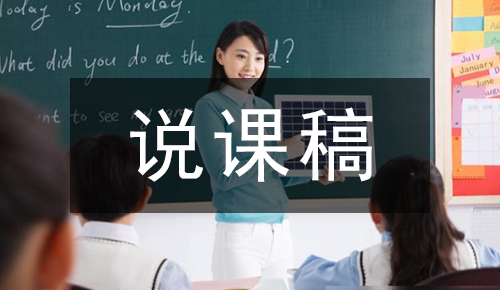
I have been ready to begin thisrepresentation with six parts. Analysis of the teaching material, the students,the teaching aims, the important and difficult points, the studying methods,and the teaching procedure.
Part 1 Teaching Material
The content of my lesson is New SeniorEnglish for China Book_3__ Unit_4_. This unit is about_Astronomy: the scienceof the stars. By studying of this unit, we’ll enable students to know sth. aboutastronomy and science of the stars and develop the interest in_science andlearning English.At the same time, let the students learn how to_use the nounclauses as the subject and distinguish the noun clauses as the subject and asthe object. From this lesson, it starts with warming up, pre-reading, readingand comprehending part. (As we all know, reading belongs to the input duringthe process of the language learning. The input has great effect on output,such as speaking and writing.) Therefore, this lesson is in the importantposition of this unit. If the Ss can master it well, it will be helpful forthem to learn the rest of this unit.
Part2 Analysis of the students
The students in Senior High School, gradeone have already learned English for years, they can speak and communicate withtheir friends in English. They are moderate, mature and sensitive. They are highlymotivated in learning English and have the ability to learn by themselves.Furthermore, the topic of this unit is about astronomy, which is full ofmystery, the students will have greater interest in learning it. However, thedifferences in english level among students is the biggest challenge. Thereforethe teacher should provide enough background information to make them better understandthe text. Therefore, I will adopt appropriate teaching methods to arouse theirinterest in learning.
Part 3 Teaching Aims
According to the new standard curriculumand the syllabus (新课程标准和教学大纲), and after studying the teachingmaterial, the teaching aims are the followings:
1.Knowledge objects (语言目标:语音,词汇,语法,功能,话题)
(1)The Ss can master the usage of theimportant words and expressions.
(2)The Ss can use the noun clauses as thesubject and as the object in the proper
situation.
(3)The Ss can understand the content ofthe lesson, talk about astronomy and get their own idea about protecting theearth.
2.Ability objects (技能目标:听,说,读,写)
(1) To develop the Ss’ abilities of listening, speaking, readingand writing
(2) To guide Ss to set up effectivestudying strategies.
(3) To improve the student’s reading ability, especially theirskimming and scanning ability.
(4) To train the Ss’ abilities of studying by themselves andcooperating .
3.Emotion or moral objects (情感目标:兴趣,自信,合作,爱国,国际视野)
(1)By completing the task, the Ss increasetheir interest in astronomy and science and set up self-confidence in learningEnglish and protect the earth in proper ways.
(2)Teach the Ss to cooperate with othersand cultivate the patriotic spirit and international visions, put the moraleducation in the language study.
Part 4 the Important and Difficult Points
Based on the requirement of the syllabus.The important points are_new words and expressions in the text, such as theory,billion, violent,fundamental, give birth to etc. The difficult points are theusages of noun clauses as the subject and as the object, how to distinguishthese two kinds of noun clauses.
Part 5 Teaching Methods
As is known to us all, a good teachingmethod requires that the teacher should help Ss develop good sense of theEnglish language. For achieving these teaching aims, (after the analysis of theteaching material and teaching aims,) I will use the following methodsaccording to the modern social communication teaching theories(现代社会交际教学理论) .
1. Communicative Approach(交际教学法)
2. Whole Language Teaching(整体语言教学法)
3. Task-based Language Teaching (任务教学法)
4. Total Situational Action (情景教学) a “scene — activity” teaching method , it establishes a realscene and the interaction between the teacher and the Ss. At the same time, CAI(电脑辅助教学) canprovide a real situation with its sound and picture, it can develop the Sscreativity in learning English.
Part 6 Teaching Procedure
Step1.Lead-in.(__10___min)
1.Ask students to read the questions inwarming up part, then discuss with their group members. After that ask severalrepresentatives to give their ideas.
2. Ask students: Do you know any bigevents in the astronomy in history? If you know, can you tell us sth. aboutthem? Are you interested in science? Do you know how earth began to form?
Purpose of my design: (1) to catch Ss’ attention about the class/topic/passage.
(2) To set up suspense/develop interest inthe astronomy and the science.
Step 2. Pre-reading
Task 1. ( pair work, __3___min)
Let Ss read the questions1-2 inpre-reading part, then work in pairs to find out the answers to the questions,then ask several students to express their ideas.
Task 2. (Individual work, __2___min)
Ask students to read the title and look atthe pictures. Predict what the reading will be about. Then ask one student tosay his/her guess.
Now, let’s see what happened in the text./ let’s check whether it is right or not.
Purpose of my design: (1) to get to knowsomething about how life began on the earth.
(2) To have a better understanding aboutthe importance of protecting the earth. Step 3. While-reading
Task 1. (Individual work __5___min)
Skimming: Ss should read the material fastto find out the main idea/topic sentence for each paragraph.
Para 1 ___________________
Para 2 ___________________
Para 3 ___________________ …
Task 2. (Individual work, __5___min)
Scanning
Read the passage carefully and then fillin the blanks with different kinds of living things.
Task 3. (Individual work __5___min)
Scanning: Guide Ss to read the materialcarefully and take some important notes, then finish th exercise 2 on P27.
Task 4. (Individual work, pair work, groupwork, class work; __5___min)
Scanning: Ask Ss to read the materialcarefully and find out the correct answers to finish the following questions.
This text can mainly divided into twostages
Stage 1 : The development of theearth(para.1-3)
(1) After the Big Bang, what was the earthlike?
(2) What happened next?
(3) What did the water vapour and gasesform?
(4) What appeared as the earth cooleddown?
(5) Why is water so important for thebeginning of life?
Stage 2 : The development oflife(para.4-5)
1.What life developed after waterappeared?
2.What life developed in water next?
3.What about the life on land?
4.What life developed next on land?
5.What life developed after forestsappeared?
6.What life developed after dinosaurs?
7.What life developed after mammals?
Purpose of my design: Enable students tounderstand the given material better by using different reading skills. Andproper competition can arouse the Ss’ interest in English learning. “Task-based” teaching method is used here to developthe Ss’ability of communication and also their ability of co-operation will be welltrained.
Step 4. Post-reading
Task 1. (Individual work __3___min)
Ask Ss to close books and finish thesummary according to their notes.
Retell the story /Sum up the passage in Ss’ own words according to the chart. Task 2.(group work, __7___min)
Discuss with other group members and thenchoose a reporter to share their opinions about the questions with the wholeclass.
How life began on earth is one of thebiggest puzzles that scientists found hard to solve.
1.What other puzzles are hidden in thepassage?
2. According to the evolution of life onthe earth, why was the earth different from the other planets?
3. Can you imagine the reason whydinosaurs disappeared?
4. As the earth is heavily polluted by ushumans, what should we do to make up for it?
Purpose of my design: I think If the Sscan finish this task well, they will benefit a lot in their spoken English.Most Ss can take their parts in the activities, especially for the Ss who havetrouble in English study.
Step 5. Homework
1. Review the new words and expressions inthe text
2. Finish the exercises 1-3 on P28.
Purpose of my design: Homework is soimportant and necessary for to master the knowledge they learned after class.It will check whether the Ss achieve the teaching aims.
必修3unit4说课稿二
必修三Unit 4 Astronomy: The science of the stars
Reading 公开课说课稿
一、说教材
本单元的中心话题是“天文学”,内容涉及太阳系、地球上的生命起源、宇宙大爆炸、月球探秘等,主要内容围绕地球上生命的起源展开的。本次阅读课“How Life Began On The Earth”通过对宇宙大爆炸理论进行科学性分析,推断出地球上生命的由来以及生物进化的过程。
二、说学生
“How Life Began On The Earth”这一话题虽然有趣,但本文的文体属于科普类说明文,内容抽象,用词多专业术语,阅读本文对高一学生来说有一定的难度.。不过本文以时间为线索,使得学生较易读懂本文的内容。通过对本文的阅读,学生不仅可以了解地球上生命的起源以及发展过程,还可以掌握一些相关的语言知识。
三、说教学目标
1. 知识目标:
(1)让学生在阅读中学到一些有用的单词和句子。
(2)让学生了解生命的起源。
2. 能力目标:
(1)提高学生的阅读技巧:略读,细读和对本文组织结构的分析。
(2)扩大学生对地球上生物进化的知识。
3. 情感目标:
(1)培养学生对科学的兴趣并激起学生对天文学的喜爱。
(2)调动和加强学生的环保意识。
四、说教学方法
1. 使用任务型教学,让学生明确学习目标。
2. 设计问答活动来检查学生对本文的了解。
3. 让学生在讨论中学会合作学习。
4. 分别利用个人,同桌和小组活动来完成学习任务。
五、说教学步骤
StepⅠ Leading-in (1mins)
Free talk with Ss: Is there life on themoon or other、planets?
设计意图:通过对Warming up的回忆引出本课话、题,了解学生对生命起源知识的掌握情况。
StepⅡ Pre-reading (4mins)
1. What’s the title of the text?Who are ourancestors?
Do you know some stories about it?
2. How did the universe begin? 设计意图:进一步激发学生的学习兴趣,激活其已有的知识,贴近了学生生活,又可以让学生对新单元的内容产生一种期待和渴望,使学生在心理上和认知上做好准备,激发他们对课文的学习兴趣并进行积极思考,从而培养其创造性的思维能力
StepⅢ While-reading (20-25mins)
Task 1: Skimming (5mins)
Read the passage quickly and match themain idea with each paragraph。设计意图:通过问题,使学生对本文有初步的了解,培养学生快速获取信息、解决问题的能力。
Task 2: Scanning (10-12mins)
Get Ss to read the passage once again andanswer the following questions.
1. When did the “Big Bang” happen?
2. What form was the earth after the “Big Bang”?
3. What made up the earth’s atmosphere?
4. How did water come into being on theearth?
5. What’s the importance of the presence of wateronthe earth?
6. What was important to the developmentof fish?
7. What made possible the rise of mammalson the earth?
8. Why are mammals different from all lifeforms in thepast?
Task 3: Read for the organization &logic (5mins)
1. By the way, what order is the passageorganized in? (Time order ).
2. Let Ss finish Exercise 2 on Page 27within 3 minuets and check the answers altogether. Let them work with theirpartners.设计意图:训练学生分析概括能力,培养学生捕捉信息以及归纳信息的能力,采用图文并茂的形式更加形象地帮助学生分析文章的结构和脉络,整体把握地球生命起源和进化的概况。
StepⅣ Post-reading (5mins)
Task 4: Group discussion: As a student,What can we do for taking care of the earth?
1. Let Ss turn around and discuss ingroups and then choose a spokesman for the group.
2. Collect the answers from the groups andshow the possible answers for Ss. 设计意图:训练学生回答问题并向全班汇报, 开拓学生的思维并锻炼他们的语言表达的能力,加强学生的环保意识, 从身边的小事做起。
StepⅤ Homework (2mins)
1. Read the passage after class andunderline the language
points you don’t understand in the text.
2. write a short passage about "Howto Protect the Earth" within 100 words.设计意图:训练学生正确运用所学的词汇,加深对课文内容和语言知识的理解,培养学生的归纳能力。
六、自我评价和反思
在本节课的准备和实施过程中,我始终牢牢把握《新课标》的思
想精髓,努力从学生实际和教学要求出发,内化和活化教材,为学生掌握知识创设情景、搭建平台,提供指导和服务。从课堂运行和对学生在课后的反馈来看,学生的参与面较广,积极性和学习的热情较高,更重要的是绝大多数同学能够完成课堂内外的训练题目,说明对知识的内化效果比较明显。通过课后思考,我也认识到课堂教学中还存在不尽如人意的地方,我会认真听取各位领导和同行老师的指教,积极学习,努力改进,力争把教学工作做得更好。在此,向大家对我的支持表示诚挚的感谢!
必修3unit4说课稿三
Unit 2 Astronomy: the science of the stars—Listening and discussing
Good morning/afternoon, everyone! Im veryglad to stand here to interpret my lesson. Today my topic is “Astronomy: the science of the stars”(Listening and
discussing part). I am going to introducemy lesson from the following aspects: the analysis of teaching material andstudents, teaching aims, teaching key points and different points, teaching andstudying methods, teaching procedures and blackboard design.
Ⅰ. Analysis of the teaching material
First of all, let’s focus on the analysis of teachingmaterial. This unit is about
astronomy, for example, the origin ofearth, the theory of the Big Bang. The listening part is about the developmentof gravity and it can help students be more curious about astronomy.
Ⅱ. Analysis of the students
Then, I’d like to talk something about mystudents. They already have learned
some basic listening skills, while theyare very unfamiliar to the gravity . Therefore, I will ask them to search moreinformation about the gravity before the class and thus make a good foundationfor this class.
Ⅲ. Analysis of the teaching aims
Based on the syllabus and the analysis ofteaching material and students, I set the teaching aims as follows:
Knowledge aims:
1. Students will get to know some usefulwords and expressions.
2. Students will know some scienceknowledge about gravity.
Ability aims:
1.Students can enhance their noting andgetting information ability.
2.Students’ reading and speaking ability can beimproved by the end of the class. Emotional aims:
1.Students will know more about astronomyand stimulate their love for science.
2. their team work spirit can also beimproved by the end of this lesson.
Ⅳ. Analysis of the key and difficult points
According to the aims of three-dimension,the key point of this lesson is to get Students know something about astronomyand enhance their capacity of
generalization and get the main idea. Andthe difficult point is that students can understand how the idea of gravity hasdeveloped over a long period of time.
Ⅴ. Analysis of teaching and studyingmethods
To help students achieve the teaching aimsmuch easier, I will mainly use
task-based teaching method, multimediamethod and communicative teaching method and so on. For students, I willencourage them to learn to cooperate with their classmates to let them becomethe real host of the class. 备考指导
Ⅵ. Analysis of the teaching procedures
Step 1 Warming up
After greeting with students ,I will askstudents to talk about their favorite
scientists. Before they talk about theirfavorite scientists ,I will tell them my favorite scientists Qian Xuesen likethis: My favorite scientists is Qian Xuesen. He refuse the invitation ofAmerican government and came back to china, making a great
contribution to the development of Chinesescience .How about you ? Who is your
favorite scientist?转载请注明出处!本文地址:
https://www.lfppt.com/worddetails_75827242.html最新说课稿文档
-
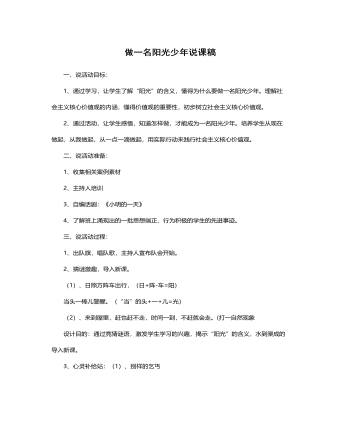
做一名阳光少年说课稿
1、紧密联系学生的生活实际,所选材料、所有活动均本着为主题服务的原则。2、形式多样化。通过心灵补给站、我来当编剧、心动不如行动等丰富多彩的活动,激发学生的热情,充分发挥他们的主体性。3、用生活中的真人真事激励他们,震撼他们的心灵,对学生进行教育,让他们得到感悟。五、说评价方式:要真正发挥主题队会的教育作用,千万不能把主题队会开成“检讨会”、“批评会”。兴趣是最好的老师,在课堂上,学生有了兴趣,才会有学习的动机,所以,在教学过程中,我努力把学生当作一个平等的朋友来对待,对于学生的回答进行评价时,本着“多表扬少批评,多鼓励少指责”的原则,尽量不用指令性、批评性的语言,最大限度的挖掘学生的优点,进行激烈性评价。

追思先烈魂,弘扬爱国情说课稿
环节四深入实践——弘扬爱国情爱国不是一句口号,要将爱国情怀落实到行动中去,队员们在各队队长的组织下,商讨出了落实方案。1、第一小队和第二小队组成了先烈故事演讲团,利用班会十分钟的时间,在三四年级宣讲先烈故事。2、第三小队和第四小队组成了创编小能手,编唱了爱国童谣、爱国拍手歌,告诉大家,爱国无处不在,爱国要从小事做起。3、第五小队和第六小队编写的爱国倡议书,提倡大家让爱国从口号落实到行动。4、全体队员共同宣誓:时刻准备着,为共产主义事业而奋斗,将活动推向了高潮。环节五大队辅导员总结“风雨沧桑,多遭铁蹄践踏,未有沉沦终奋起;荡涤污浊,重聚华夏精魂,披荆斩棘勇向前。”让我们牢记自己是中国人,怀一颗中国心,明确方向,努力奋斗,早日实现自己的梦想。
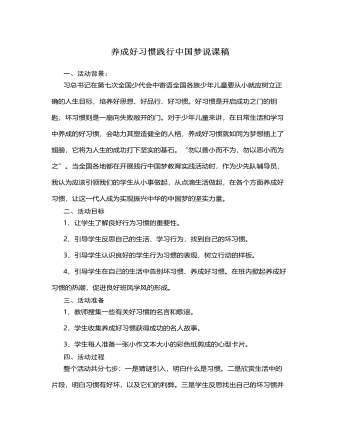
养成好习惯践行中国梦说课稿
第七步:全班学生一起倡读承诺书:(课件出示)我们都是小学生,培养习惯最要紧;上课应当专心听,积极开动小脑筋;作业认真仔细做,按时完成交得勤;有了错误要订正,知识才能学得清;人生要有好习惯,我们牢牢记心上。最后请学生把自己要养成的好习惯写在心意卡上,写好后粘贴在教室后面的园地里,互相督促,使得此次活动教育延续课后,直至影响一生.5、活动效果及反思此次活动开展后,学生们增强了对自身的认识,很多学生下决心改掉自身的坏习惯,并逐步采取了实际行动,从身边的小事做起,而且在学生中间还兴起了互相帮助、互相指正、争相进步的热潮。通过此次活动我也切实的体会到养成教育要开展就要落到实处,从实际出发,让学生亲自去感受,去体会,并且要持之以恒的做下去。同时作为老师更应该有一颗敏感热情的心,随时发现学生身上的闪光点与不足,多指正、多指点、多鼓励、多表扬,做到时时处处皆教育,这样才能赢得孩子,做好教育。
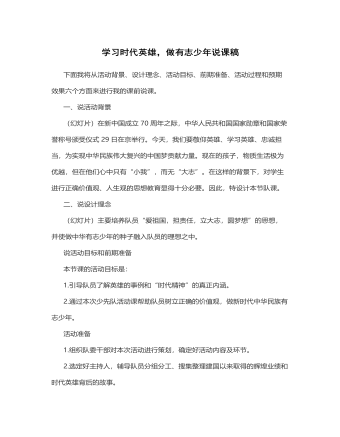
学习时代英雄,做有志少年说课稿
一、说活动背景(幻灯片)在新中国成立70周年之际,中华人民共和国国家勋章和国家荣誉称号颁受仪式29日在京举行。今天,我们要敬仰英雄、学习英雄、忠诚担当,为实现中华民族伟大复兴的中国梦贡献力量。现在的孩子,物质生活极为优越,但在他们心中只有“小我”,而无“大志”。在这样的背景下,对学生进行正确价值观、人生观的思想教育显得十分必要。因此,特设计本节队课。二、说设计理念(幻灯片)主要培养队员“爱祖国,担责任,立大志,圆梦想”的思想,并使做中华有志少年的种子融入队员的理想之中。说活动目标和前期准备本节课的活动目标是:1.引导队员了解英雄的事例和“时代精神”的真正内涵。2.通过本次少先队活动课帮助队员树立正确的价值观,做新时代中华民族有志少年。
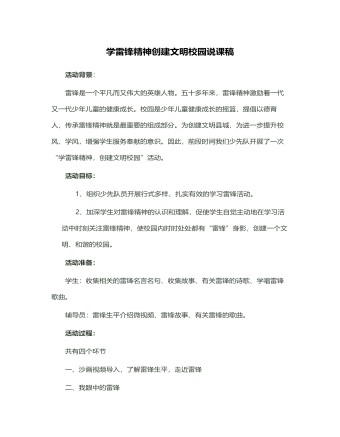
学雷锋精神,创建文明校园说课稿
雷锋精神是什么?这一环节是让学生用简单的词语或句子概括。通过这一活动,让学生概括出雷锋精神的内涵:像无私奉献、乐于助人、为人民服务、勤俭节约、尊老爱幼、勤奋好学、干一行爱一行、言行一致等等都是雷锋精神的体现。我们少年儿童是中国的未来和希望,雷锋精神的发扬和光大,创建文明校园的任务就落在他们的肩上,所以在这里我还设计了为发扬雷锋精神,创建文明校园“我该怎么做”这样的问题,目的就是让他们一起行动起来,学雷锋做好事,并制作了“荣誉”旗,奖励身边的好人好事。活动延伸:这里我设计了一个角色游戏活动——我要义卖献爱心,这个游戏学生们表现得非常积极,他们收集了自己不要的小文具或小玩具,将他们拿到集市上去卖,卖东西获得的钱,捐给王奶奶的孙女,因为王奶奶的孙女生病了,无钱治病。我觉得这个游戏使学生们懂得,一个人只要有爱心,只要愿意去帮助别人,无论什么方式都行,而且在游戏活动中孩子们体会到了帮助别人是一件多么多么快乐的事呀。
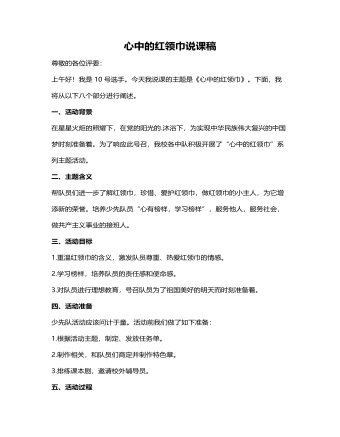
心中的红领巾说课稿
1.学习“最美红领巾”。图文结合,学习“美德少年”刘华婷、刘颖等人的先进事迹。2.记录“平凡红领巾”。展示队员们活动前精心准备的“随手拍”,发现普通队员在日常生活中的闪光点。3.填写“我为红领巾添光彩”心愿卡,对学生进行理想教育。4.齐唱《红领巾之歌》,点燃信念火种。5.辅导员对此次活动进行总结,并颁发特色章。(出示三个特色章图标)六、活动延伸红领巾精神需要代代相传,珍爱红领巾的意识需要时时提醒,本次活动后,我们会开展“小小新四军”、“鲜艳的红领巾”等后续活动,帮助队员们将红领巾精神永远铭记在心。七、引导要点四年级队员具备一定的活动能力和经验,通过课本剧的亲身体验、心愿卡的真情表达等多种方式的运用,引导队员热爱红领巾,以红领巾精神指引自己健康成长。八、活动评价本次活动,队员们受到了良好的教育。但是四年级队员自我约束能力不够强,缺乏持久性,萌生的意识和激情往往只停留在活动时,不能在活动后内化为自觉行为,这些问题有待探究。
今日更新Word
-
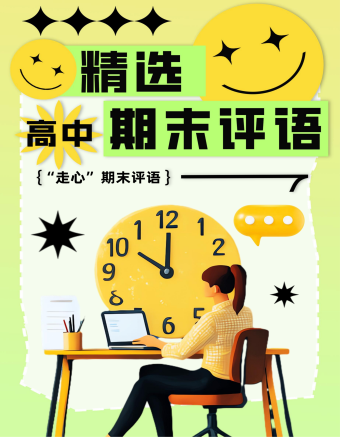
精选高中生期末评语
1、该生学习态度端正 ,能够积极配合老师 ,善于调动课堂气氛。 能够积极完成老师布置的任务。学习劲头足,听课又专注 ,做事更认 真 ,你是同学们学习的榜样。但是,成绩只代表昨天,并不能说明你 明天就一定也很优秀。所以,每个人都应该把成绩当作自己腾飞的起 点。2、 你不爱说话 ,但勤奋好学,诚实可爱;你做事踏实、认真、为 人忠厚 ,是一个品行端正、有上进心、有良好的道德修养的好学生。在学习上,积极、主动,能按时完成老师布置的作业,经过努力 ,各 科成绩都有明显进步,你有较强的思维能力和学习领悟力,学习也有 计划性,但在老师看来,你的潜力还没有完全发挥出来,学习上还要有持久的恒心和顽强的毅力。
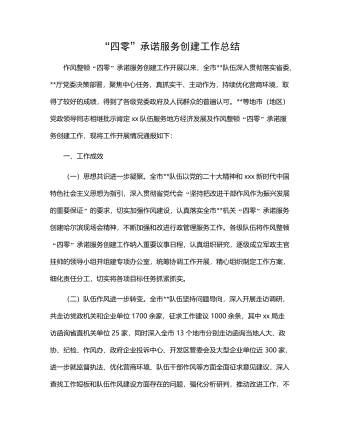
“四零”承诺服务创建工作总结
(二)坚持问题导向,持续改进工作。要继续在提高工作效率和服务质量上下功夫,积极学习借鉴其他部门及xx关于“四零”承诺服务创建工作的先进经验,同时主动查找并着力解决困扰企业和群众办事创业的难点问题。要进一步探索创新,继续优化工作流程,精简审批程序,缩短办事路径,压缩办理时限,深化政务公开,努力为企业当好“保姆”,为群众提供便利,不断适应新时代人民群众对政务服务的新需求。(三)深化内外宣传,树立良好形象。要深入挖掘并及时总结作风整顿“四零”承诺服务创建工作中形成的典型经验做法,进一步强化内部宣传与工作交流,推动全市创建工作质效整体提升。要面向社会和公众庄严承诺并积极践诺,主动接受监督,同时要依托电台、电视台、报纸及微信、微博等各类媒体大力宣传xx队伍作风整顿“四零”承诺服务创建工作成果,不断扩大社会知情面和群众知晓率。
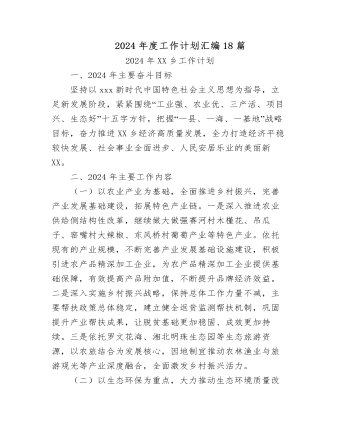
2024年度工作计划汇编(18篇)
1.市政基础设施项目5项,总建设里程2.13km,投资概算2.28亿元。其中,烔炀大道(涉铁)工程施工单位已进场,项目部基本建成,正在办理临时用地、用电及用水等相关工作;中铁佰和佰乐(巢湖)二期10KV外线工程已签订施工合同;黄麓镇健康路、纬四路新建工程均已完成清单初稿编制,亟需黄麓镇完成图审工作和健康路新建工程的前期证件办理;公安学院配套道路项目在黄麓镇完成围墙建设后即可进场施工。2.公益性建设项目6项,总建筑面积15.62万㎡,投资概算10.41亿元。其中,居巢区职业教育中心新建工程、巢湖市世纪新都小学扩建工程已完成施工、监理招标挂网,2月上旬完成全部招标工作;合肥职业技术学院大维修三期已完成招标工作,近期签订施工合同后组织进场施工;半汤疗养院净化和医用气体工程已完成招标工作;半汤疗养院智能化工程因投诉暂时中止;巢湖市中医院(中西医结合医院)新建工程正在按照既定计划推进,预计4月中下旬挂网招标。
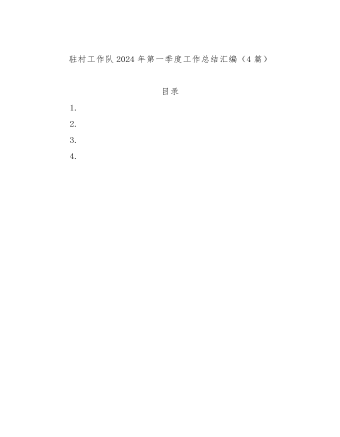
驻村工作队2024年第一季度工作总结汇编(4篇)
三是做大做强海产品自主品牌。工作队于xx年指导成立的冬松村海产品合作社,通过与消费帮扶平台合作,在工作队各派出单位、社会团体、个人支持下,已获得逾xx万元销售额。2022年底工作队推动合作社海产品加工点扩建的工作方案已获批,待资金下拨后将正式启动扩建工作。四是积极助企纾困,带动群众增收致富。工作队利用去年建立的xx镇产业发展工作群,收集本地企业在产品销售、技术、人力、资金、运营、用地等方面的需求,并加大xx支持乡村振兴力度,xx助理赴各村委开展多场xx政策支持乡村振兴宣讲活动,本季度有x万元助农贷款获批,xx万贷款正在审批中。在壮大既有产业的同时,完善联农带农机制,一方面鼓励企业雇用本地农户就业,另一方面计划与本地农户签订长期收购合同,让农民种得放心、种得安心,带动当地群众共同致富。

主题教育总结常用提纲大全
第一,主题教育是一次思想作风的深刻洗礼,初心传统进一步得到回归。第二,主题教育是一次沉疴积弊的集中清扫,突出问题进一步得到整治。第三,主题教育是一次强化为民服务的生动实践,赤子之情进一步得到提振。第四,主题教育是一次激发创业担当的有利契机,发展层次进一步得到提升。2.第一,必须提领思想、武装思想。第二,必须聚焦问题、由表及里。第三,必须领导带头、以上率下。第四,必须务实求实、认真较真。3.一是抬高政治站位,坚持大事大抓。二是坚持思想领先,狠抓学习教育。三是突出问题导向,深入整改纠治。四是坚持领导带头,发挥表率作用。4.一是立足“早”字抓筹划。二是着眼“活”字抓学习。三是围绕“统”字抓协调。5.一是形势所需。二是任务所系。三是职责所在。四是制度所定。6.一要提升认识。二要积极作为。三要密切协作。
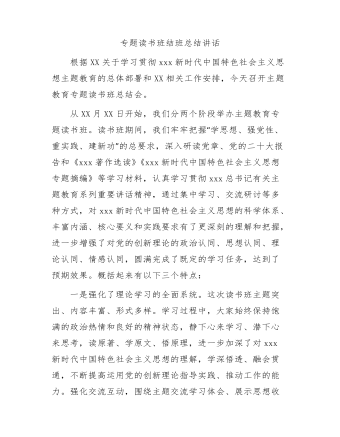
主题教育专题读书班结班总结讲话
第二,要把调查研究贯穿始终,实干担当促进发展。开展好“察实情、出实招”“破难题、促发展”“办实事、解民忧”专项行动,以强化理论学习指导发展实践,以深化调查研究推动解决发展难题。领导班子成员要每人牵头XX个课题开展调查研究,XX月底前召开调研成果交流会,集思广益研究对策措施。各部门、各单位要制定调研计划,通过座谈访谈、问卷调查、统计分析等方式开展调查研究,解决工作实际问题,帮助基层单位和客户解决实际困难。第三,要把检视问题贯穿始终,廉洁奉公树立新风。认真落实公司主题教育整改整治工作方案要求,坚持边学习、边对照、边检视、边整改,对标对表xxx新时代中国特色社会主义思想,深入查摆不足,系统梳理调查研究发现的问题、推动发展遇到的问题、群众反映强烈的问题,结合巡视巡察、审计和内外部监督检查发现的问题,形成问题清单。


















